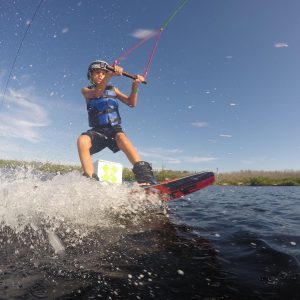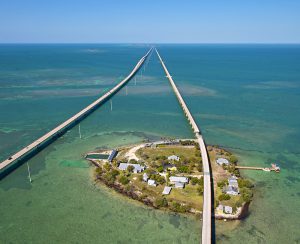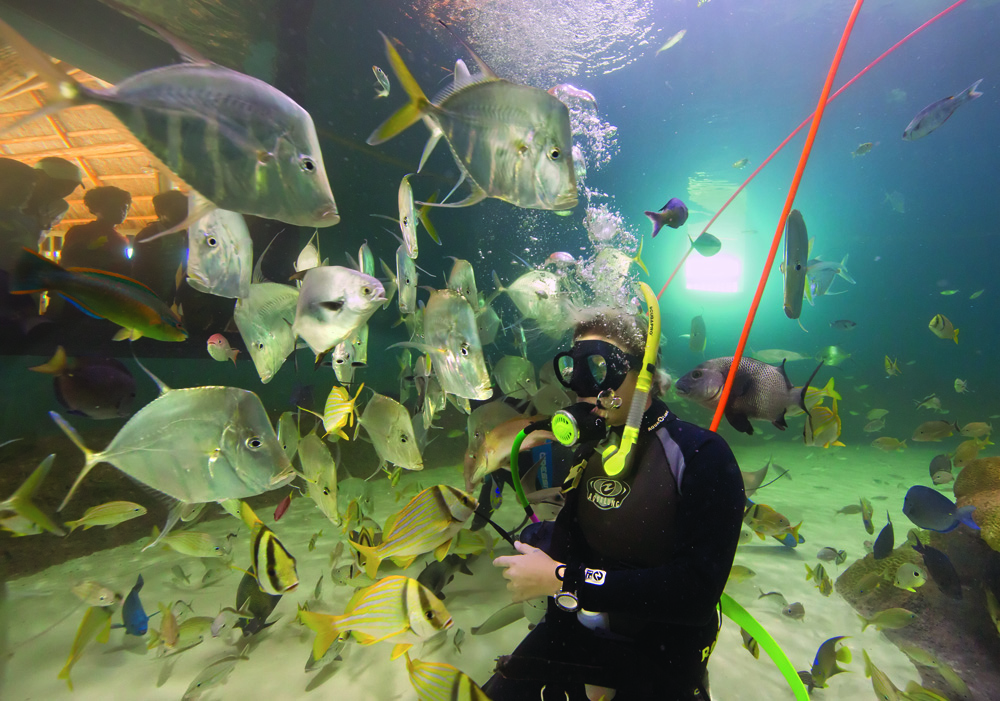The islands of Marathon in the Middle Keys include Boot, Knights, Hog, Vaca, Stirrup, Crawl and Little Crawl keys, East and West Sister’s Island, Deer and Fat Deer keys, Long Pine and Grassy keys.

The Lagoon on Grassy Key is a great spot for visitors to learn and enjoy a variety of board, wind, and paddle sports.
Marathon got its name in the early 1900s from workers constructing the monumental Florida Keys Over-Sea Railroad, whose track stretched from mainland Florida throughout the Keys. Working night and day to meet the grueling construction schedule, crew members reputedly said, “This is getting to be a real Marathon.”
Appealing to multigenerational families and recreational boaters, Marathon’s bustling community boasts cozy inns, luxury resorts, waterside vacation homes, RV parks, marinas and plenty of dining and natural attractions.
What are some “don’t miss” stops when you’re visiting Marathon?
The Lagoon on Grassy Key. Founded in 2011 as Keys Cable Park and reborn in 2020 as The Lagoon on Grassy Key, this Middle Keys favorite was created for teaching locals and visitors alike to enjoy board, wind and paddle sports. Tides flow freely in and out of the lagoon with clean ocean water. Previously a limestone quarry and an aquaculture site, today the mile marker 59 facility is a tropical adventure park, organic marketplace and day resort.
Dolphin Research Center. This acclaimed nonprofit marine mammal research and education facility, located at mile marker 59 on Grassy Key, features a swim program called Dolphin Encounter. Meet the Dolphin, Paint With a Dolphin and a Family Dolphin Splash — offering the opportunity to get waist-deep in water with the resident marine mammals — also can be enjoyed.

Turtle Hospital staffers Bette Zirkelbach and Richie Moretti, front left and right respectively, and other volunteers, help guide a tub containing Booga, a 125-pound loggerhead sea turtle, to be released at Sombrero Beach in Marathon. (Photo by Bob Care, Florida Keys News Bureau/HO)
Curry Hammock State Park. Fishing, swimming, kayaking and picnicking are among the attractions at the waterfront park, located at mile marker 56.2 on Little Crawl Key. The spot also is a popular beach launch for kiteboarders and a viewing area for the fall migration of birds of prey such as falcons, hawks, ospreys, eagles and kites.
The Art Studio. Visiting and resident art lovers in the Middle Keys can explore and express their own creativity at The Art Studio, located at mile marker 53.6 oceanside. Workshops on painting in oil, watercolor and acrylic, as well as sculpting and painting pottery, are among the most popular at the working studio — which is accented by a Coffee Loft and free Wi-Fi. Other offerings teach enthusiasts how to throw clay, fuse glass, create jewelry and paint and glaze ceramics.
Florida Keys Aquarium Encounters. Feeding the fish isn’t permitted in the open waters of the Florida Keys National Marine Sanctuary — but at this unique spot at mile marker 53, families can swim with and feed the fishes while learning about the region’s marine habitats. Visitors can safely feed sharks and other predators through small holes in a thick acrylic barrier. Another highlight is interacting with debarbed spotted eagle and cownose stingrays. Other interactive experiences are also available.
Crane Point Hammock Museum & Nature Trail. This 63.5-acre tract at mile marker 50.5 is one of the most important historic and archaeological sites in the entire Florida Keys. Crane Point contains evidence of prehistoric Indian artifacts and was once the site of a Bahamian village. Other features include the Museum of Natural History of the Florida Keys and the Florida Keys Children’s Museum, a kayak launch, nature trails, a wild bird rehabilitation center and natural habitat for birds and butterflies.

The 5-acre island of Pigeon Key lies beneath the Old Seven Mile Bridge, an iconic Middle Keys landmark. (Photo by Andy Newman, Florida Keys News Bureau)
Sombrero Beach. The well-maintained Middle Keys gem is a free-access public park and beach, open daily from sunrise to sunset at mile marker 50. Attractions include a kayak launch, volleyball courts, children’s playground, shady picnic pavilions, freshwater shower and restroom facilities. The park at Sombrero Beach is wheelchair accessible.
Turtle Hospital. Opened in 1986 at mile marker 48.5, the Turtle Hospital treats injured sea turtles and, whenever possible, returns them to the wild. Daily educational tours introduce visitors to the resident sea turtles and the hospital’s healing programs for loggerhead, green, hawksbill and Kemp’s ridley turtles.
Pigeon Key. Historic Pigeon Key, lying beneath the Old Seven Mile Bridge at mile marker 44.8, formerly served as a camp for laborers constructing the iconic bridge. The island now features a museum, offers opportunities to picnic and snorkel, and hosts a marine science research program for school-age children from around the world. Daily tours are available, with ferry boat transportation to the island.
Want to know more about the Middle Keys and their unique attractions? Just click here.

